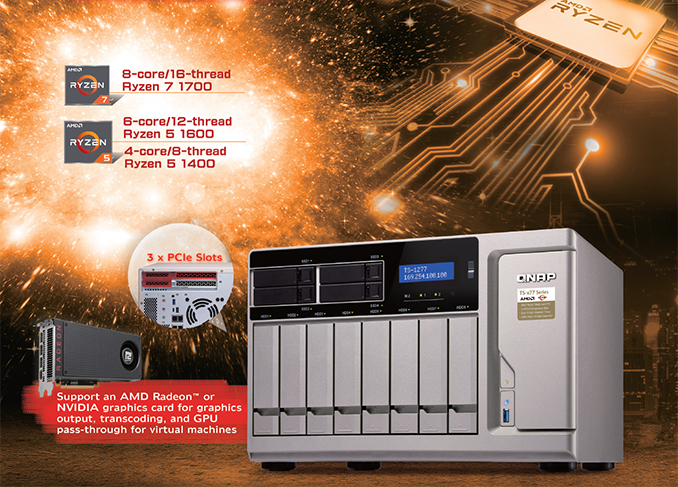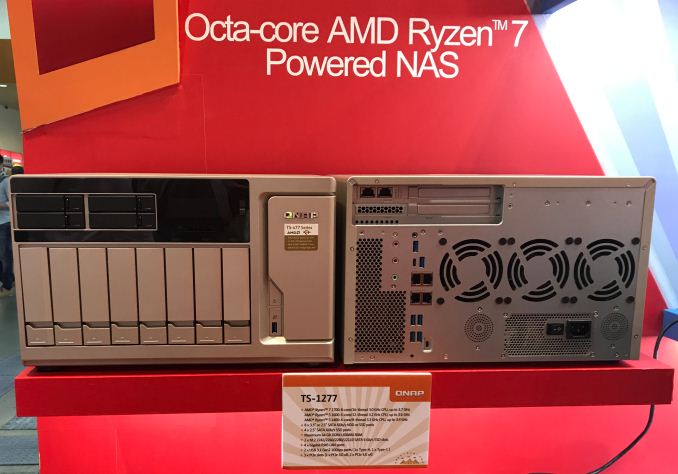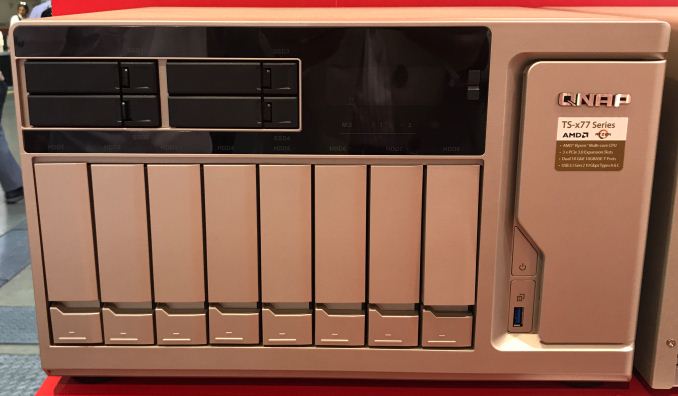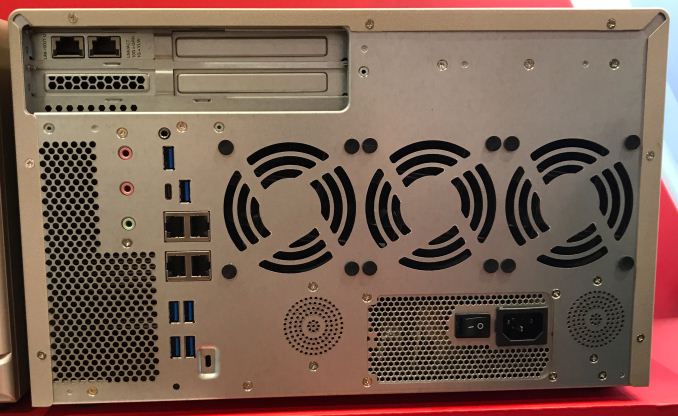QNAP Launches TS-1277 NAS Powered by AMD's Ryzen CPUs: 12 Bays, 64 GB DDR4, Starts at $2,299
by Anton Shilov on June 10, 2017 12:00 PM EST- Posted in
- Computex 2017
- NAS
- QNAP
- Ryzen

QNAP demonstrated its upcoming 12-bay NAS devices at Computex 2017, including most notably models powered by AMD’s Ryzen processors. The NAS will support HDDs and SSDs in various form-factors and will start at $2,299. In addition, the company is prepping 6-bay and 8-bay NAS featuring AMD’s Ryzen CPUs that will be more affordable.
The QNAP TS-1277 series NASes are powered by AMD’s Ryzen 7 1700 or Ryzen 5 1600 CPUs with eight and six cores respectively, and come with up to 64 GB of DDR4-2400 DRAM. All the systems use four GbE ports to connect to networks and have eight 3.5”/2.5” bays as well as four 2.5” bays for various SATA storage devices. As you'd expect for a NAS, there's a multitude of RAID options available, with the NAS hardware able to tap the large number of drives here for RAID 50/60 operation. In addition, the NASes feature two M.2 slots (up to M.2-22110) for SSDs that can cache frequently used data.
Meanwhile, the TS-1277 has one PCIe 3.0 x8 and two PCIe 3.0 x4 slots, and thus can be upgraded with QNAP's QM2 PCIe cards, which offer options such as 10GbE networking and additional M.2 slots. For those who needs to have access to the TS-1277 from a local PC or to a DAS, the NAS has two USB 3.1 ports (Type-A and Type-C) and five USB 3.0 headers (Type-A). As for power, the TS-1277 is equipped with a 550 W PSU and can handle all kinds of HDDs and SSDs (as long as they are compatible with SATA-6G and do not require management by the host) as well as almost any graphics card in the PCIe 3.0 x8 slot.
The 12-bay TS-1277 NAS will not be the only model based on AMD’s Ryzen CPUs from QNAP. Along the high-end SKU, QNAP will also introduce more affordable solutions featuring six and eight bays: the TS-677 and the TS-877 with 250 W and 450 W PSUs, respectively. As for feature set, all QNAP’s TS-x77 NAS will run the company’s QTS 4.3 OS and will support the same capabilities as other NAS from the manufacturer.
QNAP is the first NAS manufacturer to start using AMD’s Ryzen processors for network area storage. AMD’s CPUs traditionally have strong integer performance, making them a good fit for NAS tasks. Meanwhile, the high core counts of the Ryzen CPUs also enables QNAP to position their TS-1277/TS-877/TS-677 NASes for hosting virtual machines or containerized applications. During a conversation at Computex, QNAP also mentioned that the prices of AMD’s Ryzen processors (relative to its rivals) were also a major factor in their decision to use Ryzen CPUs for NASes.
| QNAP TS-1277, TS-877 and TS-677 Specifications | |||||||
| TS-1277 1700-64G |
TS-1277 1700-32G |
TS-1277 1600-16G |
TS-877 1600-16G |
TS-877 1400-16G |
TS-677 1400-8G |
||
| CPU | AMD Ryzen 7 1700 8C/16T 3 GHz/3.7 GHz 20 MB Cache (L2: 4 MB, L3: 16 MB) 65W TDP |
AMD Ryzen 5 1600 6C/12T 3.2 GHz/3.6 GHz 19 MB Cache (L2: 3 MB, L3: 16 MB) 65W TDP |
AMD Ryzen 5 1400 4C/8T 3.2 GHz/3.4 GHz 10 MB Cache (L2: 2 MB, L3: 8 MB) 65W TDP |
||||
| Encryption Acceleration | AES-NI | ||||||
| Memory | Speed | DDR4-2400, dual-channel | |||||
| Capacity | 64 GB (4×16 GB) | 32 GB (2×16 GB) |
16 GB (2×8 GB) |
8 GB (2×4 GB) |
|||
| Bays | 8 × 3.5" 4 × 2.5" |
6 × 3.5" 2 × 2.5" |
4 × 3.5" 2 × 2.5" |
||||
| M.2 Slots | 2×M.2 slots (up to M.2-22110) | ||||||
| Storage interface | SATA 6 Gbps | ||||||
| Ethernet | 4×GbE, 10/40 GbE supported via add-in-cards | ||||||
| PCIe Slots | 1 × PCIe 3.0 x8 2 × PCIe 3.0 x4 |
||||||
| Audio | 2 speakers 1 × audio out 2 × audio in |
||||||
| USB | 1 × USB 3.1 Type-A 5 × USB 3.0 Type-A 1 × USB 3.1 Type-C |
||||||
| Other I/O | Monochrome backlit LCD display with Enter & Select buttons, 3.5 mm console port, voice allert, buzzer, etc. | ||||||
| Dimensions | Height | 234.6 mm / 9.23" | 231.9 mm / 9.13" | ||||
| Width | 369.9 mm / 14.56" | 292.8 mm / 11.53" | 224.9mm/8.9" | ||||
| Depth | 319.8 mm / 12.59" | ||||||
| PSU | 550 W | 450 W | 250 W | ||||
| OS | QNAP QTS 4.3 | ||||||
| MSRP | $3099 | $2599 | $2299 | $2099 | $1899 | $1649 | |
QNAP plans to start selling its AMD Ryzen-based 12-bay TS-1277 NAS in late July. The top-of-the-range model with a Ryzen 7 1700 and 64 GB of memory will cost $3,099, a slightly cheaper SKU with the same processor, but 32 GB of DDR4 will retail for $2,599, whereas the most affordable configuration powered by AMD’s six-core Ryzen 5 1600 will be available for $2,299.
Related Reading:
- QNAP at CES 2017 - Thunderbolt 3 and Xeon D NAS Units, Residential Gateways, and More
- Thecus Announces $130 and $200 Entry-Level NASes For Home Users
- Commercial NAS Operating Systems - Exploring Value-Additions - Part I
- Commercial NAS Operating Systems - A Comprehensive Overview of Core Features
- QNAP Expands Thunderbolt NAS / DAS Lineup with TVS-x82T Series
Source: QNAP



















38 Comments
View All Comments
sorten - Saturday, June 10, 2017 - link
so this is doing double duty as a server and a NAS box?DanNeely - Saturday, June 10, 2017 - link
QNAP added virtualization support to their platform a few years back; and running a number of other VMs/etc on it is the only reason the amount of CPU/RAM makes sense.Samus - Sunday, June 11, 2017 - link
QTS (QNAP's OS) is effectively a Linux-based server OS along the lines of DSM (Synology's OS) and both have most of the functionality of Windows Server: Domain Controller, MySQL, DNS, DHCP, RAS, VPN, VM, Backup, Cloud Sync, even POP/IMAP although I don't know why anyone wouldn't just use Hosted Exchange or Gmail Pro...do people really run their own local mail servers anymore?Samus - Sunday, June 11, 2017 - link
I've replaced entry level business servers with NAS's for years. Many predicted the death of the small business server when Microsoft changed their focus to the cloud. And they are all right.jabber - Sunday, June 11, 2017 - link
Microsoft loses me with just starting to look into its server licensing. Totally mystifying. Okay a decent mid-range NAS with simple open file-sharing it is then! Most of my customers are 10 users or fewer and don't want or have a dedicated IT support dept. NAS wins.SpetsnazAntiVIP - Saturday, June 10, 2017 - link
At this price point, I would expect SAS backplanes. This doesn't make a lot of sense to me when you can get a used Dell PowerEdge T320/T620 with 1 or 2 Xeon CPU's, 6-12 DDR3 ECC slots, redundant PSU's, and 8x3.5” SAS hot swap bays for 1/4 to 1/2 the price. You could also do something like a Dell PowerEdge R510 gen 2 with 12x3.5" SAS hot swap bays for 1/4 the price. I guess if warranty and support is a concern, I could see the benefit, though.Communism - Saturday, June 10, 2017 - link
"Consumer NAS" boxes has been, and likely will be for the foreseeable future, all about fleecing the technically illiterate.webdoctors - Sunday, June 11, 2017 - link
I was thinking the same thing. With this pricing, aren't you getting into NetApp territory?msroadkill612 - Sunday, June 11, 2017 - link
My newbie hardware only 2c, is that it sounds like making a silk purse from a sows ear, with epyc mere weeks away, & then threadripper.u will always be dodging lane shortages and settling for low bandwidth.
first thing i would want is ~4 x 4 lane pcie3 m.2 nvm ports - 16 lanes there alone. 10Gb lan is ~2 lanes. If its a vm server, some 16lane gpuS would be nice.
ryzen am4 x350 has 20 lanes, x370 chipset, 24 lanes - & rigidities about splitting them for use.
Epyc/threadripper are 128/64 lane. Quite a bump.
Already we are seeing AMD x399 mobos w/ 3 x m.2 native 4 lane sockets - an expensive card as an add on.to a server.
If, as others here say, its likely to be used for VM & hence need big ram, then AMD have just the native tools for using our newfound radically faster nvme storage as vast pools of virtual memory. But first u gotta have the lanes for the lane hungry nvmeS.
If u r happy with an 8 lane gpu on ryzen/am4 - maybe.
Morawka - Sunday, June 11, 2017 - link
8 lane works fine for GPU's as long as it's PCIE 3. Gaming laptops have been using less for years.